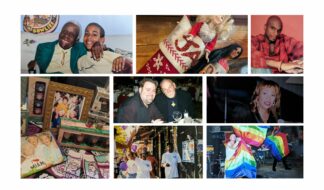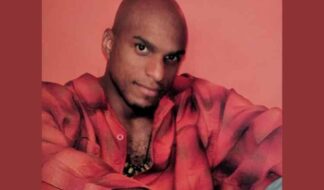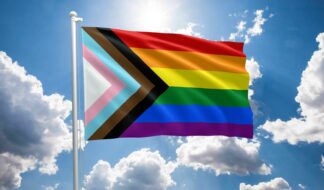"Ho Ho! Hey Hey! We won't pay to be gay!"
The chant, led by Vivian Thompson on a bullhorn and in unison with a couple dozen or so other protesters, announced the stance of Lansing People's Pride as they marched on June 17th through Old Town, home to this year's Michigan Pride celebration.
According to City Pulse, the gay, straight, and trans group was demonstrating specifically against the $10 donation/entry fee asked by the organizers of the Michigan Pride festival, and more generally against the event's ties to corporate sponsors and the U.S. police-state. They offered a non-commercial, countercultural, and highly politicized alternative to the official festivities.
Fifty years after Stonewall, Lansing People's Pride captured much of the character and spirit of the original Stonewall uprising: youthful, diverse, angry yet campy, outcast, disruptive, with people who defied conventional gender expectations at the forefront, people we might now identify and who would likely now identify themselves as transgender.
In June 1969, patrons of the Stonewall Inn in Greenwich Village fought back against yet another routine police raid of a gay bar, triggering several nights of rioting and, subsequently, inspiring new queer organizing on a mass scale across the country.
Tens of millions recognize Stonewall each year as the milestone event that launched the modern LGBTQ movement. Or the gay rights movement. Or Gay Liberation. Depending on your perspective and politics.
Inside the fenced-in area of Michigan Pride, a large crowd, notably diverse, mingled from booth to booth along Turner Street amongst vendors and organizations that included a kid's activity tent, numerous booths hosted by local LGBTQ-friendly churches of various denominations, a table for the county Dems, and a booth seeking recruits for the Michigan State Police.
The official event conveyed messages of arrival and acceptance, safety, some gender and sexual fluidity, and a larger mainstreaming of LGBTQ culture.
In contrast, Lansing People's Pride echoed a popular t-shirt phrase: Remember, Stonewall Was a Riot.
Indeed.
But what if we consider an alternate take? Remember, Stonewall Was a Bar.
As revealed in primary source texts in the new must-read "The Stonewall Riots: A Documentary History," edited by Marc Stein, the Stonewall Inn was actually rather unsanitary, so much so that its unwashed glasses contributed to an epidemic of hepatitis among gay New Yorkers in the late 1960s.
"The Homosexual Handbook," published the year of the uprising, describes the Stonewall Inn as a "haven of and for narcissists." Other accounts take note of its go-go boys.
What are the implications of this? Was the bravery of the first night at least in part alcohol-induced, albeit with liquor watered down by the Stonewall's Mafia owners? What if the Stonewall uprising was little more than a drunken outburst akin to the sofa torchings following a college sports championship?
I think not. Though, as a historian, I am trained to entertain different possible interpretations.
When we discuss Stonewall in my LGBTQ Studies course at Michigan State University, I expose my students to multiple, competing versions of the events of June 1969, with competing claims of who was there or who threw the first brick, with competing stakes.
We watch clips from Arthur Dong's 1995 documentary "OutRage '69," a segment from the PBS show "In the Life" on Stormé DeLarverie, and part of "Pay It No Mind" about Marsha P. Johnson.
We also view scenes from the 2010 film "Stonewall Uprising," different witnesses and a divergent emphasis, including the perspective of Inspector Sidney Pine, who conducted the raid. Because people of color are largely absent from this account, some feel it whitewashes the narrative.
Who was there can matter a great deal to how and why we remember Stonewall. Whose origin story is it anyway? Cis white gay guys? Butch lesbians? Transgender people?
Beyond trying to figure out what actually happened, if that can ever be fully possible, perhaps a more important question is: Why is Stonewall significant? After all, other instances of resistance, such as the 1966 Compton Cafeteria Riots in San Francisco, preceded it.
The Stonewall uprising was on a significantly larger scale than previous uprisings.
Stonewall took place in the media capital of New York, so the press attention it received reached a wider audience than earlier clashes.
The volatile atmosphere of the late 1960s, from Black Power to SDS to women's liberation to growing opposition to the Vietnam War, provided the oxygen that fanned the flames.
Stonewall prompted the formation of Gay Liberation Front groups and other mass organizing across the country, including in Michigan.
And Stonewall was commemorated on its first anniversary not only in New York but also in Chicago and Los Angeles. In years that followed, other cities joined in, including Detroit in 1972.
In a sense, Stonewall was co-opted from the start. For half a century it has provided inspiration. It has achieved mythic status and continued to wield great cultural power.
As we embrace its mixed, messy legacy, we should strive to understand it multiple meanings and multiple descendants. They stood both inside and outside the fence in Lansing's Old Town this June.
Tim Retzloff teaches history and LGBTQ studies at Michigan State University. He is at work on his first book, Metro Gay, about lesbian and gay life and politics in Metro Detroit from 1945 to 1985.










